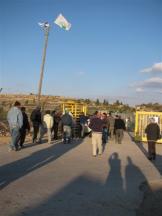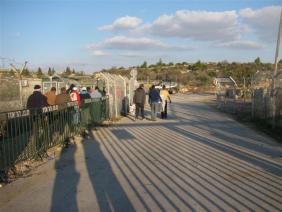Har Adar, Wed 23.11.11, Afternoon
"The invisible people and places" (borrowed from Italo Calvino’s "Invisible Cities")
Har Adar Workers’ Checkpoint/Gate
We have been meaning to come here for quite a while now, having seen how the system functions at Modi’in Ilit. Every settlement is responsible for the entry and exit of the workers possessing permits, “fortunate” in their privilege to work and make a living. And that, of course, is by far no assurance of human treatment .
.
Har Adar is a Jewish community, most of which is situated within the ‘green line’ (not that it means that much), surrounded by a security fence on all sides. It is adjacent to the Palestinian villages of Katana, Biddu, Beit Tzurif and Beit Iksa.
We used to come to Beit Iksa and Biddu from the highway exit to Ramot and observe Har Adar and the ‘Separation Barrier” as it is called by the army from the Ras Khamis Checkpoint. Nowadays all the traffic here is directed through Ramallah except for the workers who arrive here from the nearby villages a stone’s throw away.
14:40 We entered the community through the checkpoint and drove around to look for the workers’ gate, for clearly there is one. In the meantime we looked at the spectacular view and the handsome houses.
After a short drive we reached a road showing a sign “For security vehicles only”. We climbed on foot and as expected found the usual décor: a yellow metal gate with a turnstile next to it. From the turnstile to the second gate, a narrow fenced-in pedestrians’ track. The fence, police-like, shows the address of the local council of Har Adar. The track leads another 20-30 meters to an additional gate with an opening for passage. At a greater distance lies another gate and behind it, transport vans and private cars are parked .
.
Upon our arrival there were several workers already waiting, having finished their workday. The army and the Border Patrol are responsible for opening the two distant gates . The first is opened by the local council’s security department in coordination with the army. Only workers with permits to enter Har Adar are allowed in, but they do not have to deposit their IDs at the entry. Once permits were issued to 20-year olds as well, now only to men over 30. There are apparently 100-150 workers employed by the local council (this figure is unverified), private employers and contractors constructing houses and public buildings.
. The first is opened by the local council’s security department in coordination with the army. Only workers with permits to enter Har Adar are allowed in, but they do not have to deposit their IDs at the entry. Once permits were issued to 20-year olds as well, now only to men over 30. There are apparently 100-150 workers employed by the local council (this figure is unverified), private employers and contractors constructing houses and public buildings.
The gate is opened early but remains closed from 7:30 a.m. until the afternoon. This means that anyone who has only worked two hours must wait until the afternoon, when the gate is supposed to be opened.
“Supposed to be opened” is the key… 2… 3… 5 p.m.
We arrived shortly before 3 p.m. People have been waiting since 2:30. In the meantime we talked with them, they expressed their surprise at our presence. Some of them know us from the Qalandiya Checkpoint. We heard serious complaints about the Al Jib Checkpoint morning procedures. There are transport vans driven by East Jerusalem residents passing through Har Adar, delivering the workers from the gate to their workplaces. They charge 3 NIS each way. People pay that to arrive quickly and mainly not to walk around the community. The price might climb up to 20 NIS if they are in a great hurry.
The council transports its own workers to the gate in its security vehicles and we saw quite a few people driving their personal workers. It is already past 3 p.m. and more and more people arrive and tell us their harsh stories.
At the exit they have to show receipts if they are carrying anything with them, to make sure they haven’t stolen anything… If their employer has given them any used objects, he must attach a note. If he has forgotten this, they are not allowed to call him. The olive trees outside the fence and even those inside it belong to the neighboring village residents, but they are not allowed to harvest them. Even if some of them are allowed to work inside the community. As we already know, if a permit is issued then it is to the oldest member of the family who is no longer able to tend his land or harvest his own olives.
15:30 At long last those in charge from the army and the community arrive to open the gate. 60-70 people line up with their belongings and go home. Some arrive at an amok run for fear of missing the opening. A male and female soldier stand at the gate. The local council’s security official is not exactly enthused with our presence.
15:45 The gate is closed. The security official has driven off, although he saw that more people are still arriving. At the very last minutes, a van with 12 passengers arrives, having missed the opening time, as well as some more workers in a private vehicle. We were glad to note that the official returned 10 minutes later and opened the gate for the stragglers. They thanked us for this. We’re not sure, but even if our open eye did affect this one time, that does not really change things.
On our way back to our car, more and more people kept arriving. They would have to wait until 5 p.m. or later, depending on the army, the local council and their mutual coordination and good will. Which as far as we’ve heard simply does not exist. There is no possibility to phone anyone and ask for the gate to be opened!
True, some sites are much worse than this checkpoint, but the thought that even at such a fancy, normative community the same picture is seen - the Palestinians remain transparent – is outrageous. Apparently it is far-fetched to expect a worker finishing his long and exhausting workday (at a pittance) to be treated as a human being and not an object.
